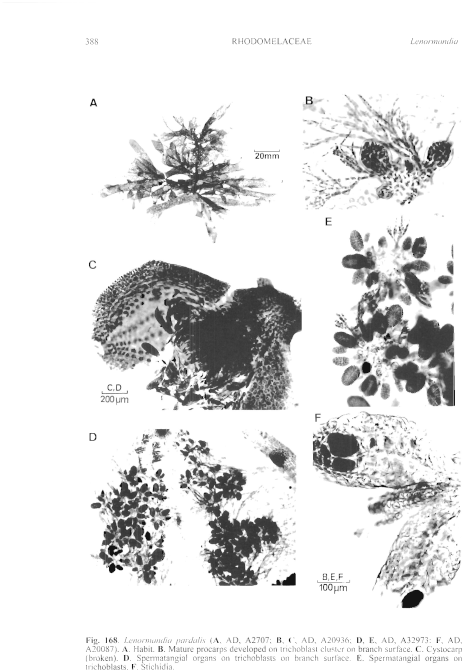|
|
|
|
|
|||||||||||
|
Electronic Flora of South Australia Species Fact Sheet
Phylum Rhodophyta – Family Rhodomelaceae – Tribe Amansieae
Selected citations: De Toni 1903: 1119. Lucas 1909: 46. Lucas & Perrin 1947: 302. May 1965: 397. Phillips 2002a: 192, figs, 2, 6, 7. Shepherd & Womersley 1981: 368.
Synonyms
Lenormandia marginata sensu Huisman & Walker 1990: 437. Silva et al. 1996: 522.
Lenormandia pusilla Sonder 1880: 32 (nom. nud.)
Thallus (Fig. 168A) medium to dark brown-red, 5–10 cm high, membranous, erect, irregularly branched from the frond surface, primary and secondary blades 3–7 cm long and 4–9 mm broad, ovate to oblong but basally constricted and with rounded apices, margins entire and sometimes slightly involute; midrib faint to distinct; tertiary blades smaller, ovate. Holdfast discoid to fibrous, 2–3 mm across; epilithic or epiphytic. Structure. Apices cleft, apical cells conical, 40–60 µm in diameter (including thick walls), axial cells cutting off 5 pericentral cells, 2 lateral ones on each side and a ventral cell, with the lateral cells becoming interposed to form the mainly one-cell broad medulla, with a cortex 1 (–2) cells thick. Surface appearance clearly rhombic areolate, cortical cells irregularly arranged, 15–40 µm across, L/D 1–2. Trichoblasts adventitious, scattered on the surface, arising from cortical cells, much branched, 0.7–1.2 mm long, basal cells 16–25 µm in diameter, L/D 1–2. Cortical cells uninucleate, medullary cells multinucleate; rhodoplasts discoid, chained in larger cells.
Reproduction: Gametophytes dioecious. Procarps (Fig. 168B) occur in clusters on trichoblasts on the blade surface, soon on polysiphonous branches. Carposporophytes with a basal fusion cell, much branched gonimoblast and clavate carposporangia 50–90 µm in diameter. Cystocarps (Fig. 168C) stalked, globose, 500–800 µm in diameter; pericarp ostiolate, 4–7 cells thick. Spermatangial organs (Fig. 168D, E) in dense clusters on branches of surface trichoblasts, ovoid, 45–75 µm in diameter, L/D 1.5–2.
Tetrasporangial stichidia (Fig. 168F) in clusters on blade surfaces, 300–600 µm long and 200–300 µm broad, ovoid, slightly compressed, corticated, with 2 tetrasporangia per segment, 70–120 µm in diameter.
Type from Port Elliot, S. Aust. (Hussey); lectotype in Herb. Agardh, LD, 42768; isotypes in MEL, 657638, 657639.
Selected specimens: Yanchep, W. Aust., drift (G. & R. Kraft, 29.ix.1990; MELU, K8561). Point Peron, W. Aust., drift (Kraft, April 1966; MELU, K1507). Hamelin Bay, W. Aust., 2–10 m deep (O'Brien, 12.i.1978; MELU, 22743). Nuyts Reef, S. Aust., 30 m deep (Shepherd, 27.iii.1980; AD, A52345). Elliston, S. Aust., drift (Womersley, 13.i.1951; AD, A13564). Port Elliot, S. Aust., drift (Womersley, 10.viii.1957; AD, A21119). Seal Bay, Kangaroo I., S. Aust., drift (Womersley, 22.xi.1968; AD, A32973). Pennington Bay, Kangaroo I., S. Aust., on Codium galeatum, drift ( Womersley, 12.i.1944; AD, A2707). Stanley Beach, Kangaroo I., S. Aust., drift (Womersley, 7.ii.1956; AD, A20087 and 6.ii.1957; AD, A20936). Robe, S. Aust., drift (Womersley, 20.xii.1953; AD, A19115). Gabo I., Vic., on Epiglossum smithiae, 18 m deep (Shepherd, 17.ii.1973; AD, A43505). Little Squally Cove, Deal I., Bass Strait, 30 m deep (Shepherd & Lewis, 3.v.1974; AD, A45212).
Distribution: Yanchep, W. Aust., to Gabo 1., Vic. and Deal 1., Bass Strait.
References:
AGARDH, J.G. (1894). Analecta Algologica. Cont. II. Acta Univ. lund. 30, 1–98, Plate 1.
DE TONI, G.B. (1903). Sylloge Algarum omnium hucusque Cognitarum. Vol. 4. Florideae. Sect. 3. pp. 775–1521 + 1523–1525. (Padua.)
HUISMAN, J.M. & WALKER, D.I. (1990). A catalogue of the marine plants of Rottnest Island, Western Australia, with notes on their distribution and biogeography. Kingia 1, 349–459.
LUCAS, A.H.S. & PERRIN, F. (1947). The Seaweeds of South Australia. Part 2. The Red Seaweeds. (Govt Printer: Adelaide.)
LUCAS, A.H.S. (1909). Revised list of the Fucoideae and Florideae of Australia. Proc. Linn. Soc. N.S.W. 34, 9–60.
MAY, V. (1965). A census and key to the species of Rhodophyceae (red algae) recorded from Australia. Contr. N.S. W. Natl Herb. 3, 349–429.
PHILLIPS, L.E. (2002a). Taxonomy and molecular phylogeny of the red algal genus Lenormandia (Rhodomelaceae, Ceramiales). J. Phycol. 38, 184–208.
SHEPHERD, S.A. & WOMERSLEY, H.B.S. (1981). The algal and seagrass ecology of Waterloo Bay, South Australia. Aquat. Bot. 11, 305–371.
SILVA, P.C., BASSON, P.W. & MOE, R.L. (1996). Catalogue of the Benthic Marine Algae of the Indian Ocean. (Univ. California Press: Berkeley.)
SONDER, O.W. (1880). In Mueller, F., Fragmenta Phytographiae Australiae. Supplementum ad volumen undecinum: Algae Australianae hactenus cognitae, pp. 1–42, 105–107. (Melbourne.)
The Marine Benthic Flora of Southern Australia Part IIID complete list of references.
Publication:
Womersley, H.B.S. (24 February, 2003)
The Marine Benthic Flora of Southern Australia
Rhodophyta. Part IIID. Ceramiales – Delesseriaceae, Sarcomeniaceae, Rhodomelaceae
Reproduced with permission from The Marine Benthic Flora of Southern Australia Part IIID 2003, by H.B.S. Womersley. Australian Biological Resources Study, Canberra. Copyright Commonwealth of Australia.
Illustration in Womersley Part IIIA, 2003: FIG. 168.

Figure 168 enlarge
Fig. 168. Lenormandia pardalis (A, AD, A2707; B, C, AD, A20936; D, E, AD, A32973; F, AD, A20087). A. Habit. B. Mature procarps developed on trichoblast cluster on branch surface. C. Cystocarp (broken). D. Spermatangial organs on trichoblasts on branch surface. E. Spermatangial organs on trichoblasts. F. Stichidia.

|
Email Contact: State Herbarium of South Australia |

|